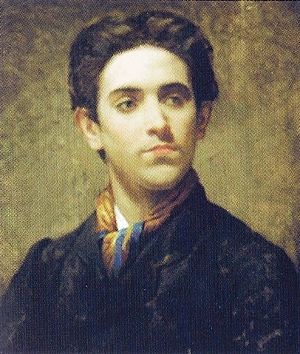Daniel Zuloaga facts for kids
Quick facts for kids
Daniel Zuloaga
|
|
|---|---|

Daniel Zuloaga; portrait by Ignacio Suárez Llanos (1830-1881)
|
|
| Born |
Daniel Zuloaga y Boneta
1852 |
| Died | 21 December 1921 |
| Nationality | Spanish |
| Known for | Ceramics, painting |
Daniel Zuloaga y Boneta (1852 – December 27, 1921) was a Spanish pottery artist and painter. He is known as one of the most important artists who made pottery an art form in Spain. He worked mainly from his studios in Madrid and Segovia. His beautiful pottery pieces can be found all over Spain.
Daniel Zuloaga also showed his art in many international exhibitions. His works are displayed in other European countries too. He was special because he used old techniques to create his art. When he was young, he worked at the Royal Palace of Madrid, just like his father. After studying in France, Daniel and his brothers opened their first shop. One of their most famous works is the outside of the Palacio de Velázquez. You can also see his art at the Palacio de Cristal and the Hospital of Maudes.
He was a pioneer in bringing ceramic arts to Spain. He even started a school to teach traditional pottery methods. He also introduced new styles like neo-renaissance and modernism to European fashion.
About Daniel Zuloaga

Daniel Zuloaga was born in 1852. He came from a family of artists who were skilled in metal work. From a young age, his family taught him these artistic skills. His father, Eusebio Zuloaga, was the director of the Royal Armoury. He was very good at damascene, which is a special way of decorating metal.
Daniel's brother-in-law, Ignacio Suárez Llanos, was also a famous painter. Daniel was the half-brother of Plácido Zuloaga. Plácido took over the family workshop from their father. Daniel went to a special school for ceramics in Sèvres, France. There, he learned all about making pottery. When he came back to Spain, he joined the Royal Factory in Moncloa.
His first big project was to create tiles for a large mining exhibition in Madrid in 1883. He decorated the Ricardo Velázquez Bosco's Velázquez Palace for this event. He worked with Velázquez on many projects. These projects were in Madrid, Segovia, and Guipúzcoa. He also took part in art shows around the world.
His nephew was the well-known painter Ignacio Zuloaga. Ignacio often painted his uncle Daniel and his family. He showed them in Spanish country scenes in many parts of the world. One of his famous paintings is called "My Uncle Daniel and his family." This painting is displayed in the Boston Museum of Fine Arts.
As Daniel Zuloaga got older, he grew a white beard. He was very famous in Spain for his amazing work in ceramic arts. He also introduced colorful tiles that showed scenes of Spanish country life. His children helped him with his art. His daughter, Esperanza, was very talented and helped him with coloring. You can see his pottery works all over Spain. His ceramic art is especially noticeable in many famous churches and buildings in Seville.
In 1905, Daniel Zuloaga bought the Church of San Juan de los Caballeros in Segovia. He turned this old church into his art studio. The design shop was in a room of the church. In another part of the church, he added colors to his baked pottery before glazing it. The special ovens, called hornos, were in the main part of the church. These ovens were heated with wood or charcoal. Another section of the church was used to store his art materials. He kept things like old books, stands, and chairs there. Daniel Zuloaga passed away in Segovia in 1921 when he was 71 years old.
See also
 In Spanish: Daniel Zuloaga para niños
In Spanish: Daniel Zuloaga para niños


